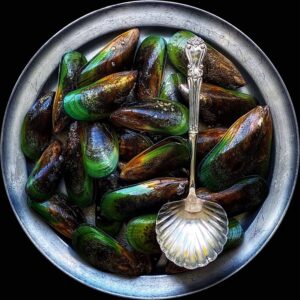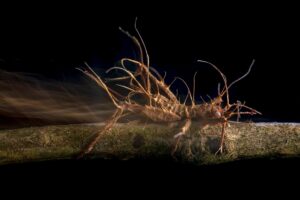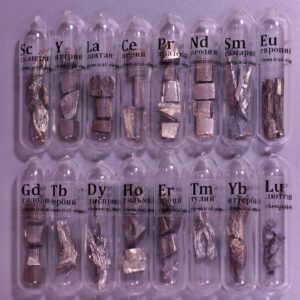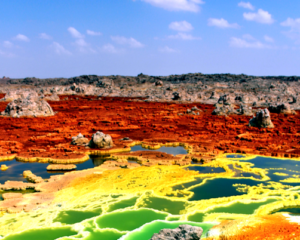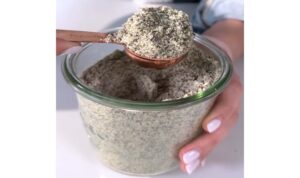These pretty Christmas tree decorations are quick to make and far more attractive than many shop-bought trinkets.
You can buy ready-cut, natural wooden discs from craft supplies shops and then they just need to be painted. Adding a personal touch to this year’s Christmas decorations is easier than you think.
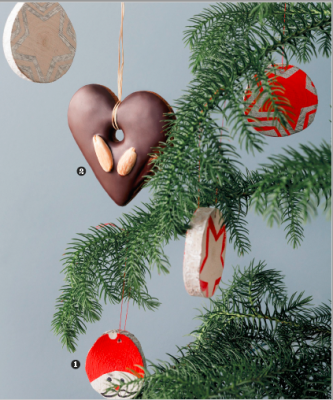 Pin
Pin  Pin
Pin You will need:
- Wooden discs, 5–6cm (2–2½in) in diameter
- Red thread
- Thin flat paintbrush
- White and red acrylic paint
- Template (see here)
- Drill and 3mm (1⁄8in) diameter drill bit
- Silver marker pen
- Scissors
How to make Painted Baubles?
Step 1: First drill a little hole about 5mm (¼in) from the edge of each disc for hanging them later.
Step 2: Now mix a bit of white acrylic paint with water to get a very thin consistency and glaze the wooden disc with it. The grain of the wood should remain visible, the colour is just a bit lighter. Let the glaze dry thoroughly.
Step 3: Now you can paint both sides of the wooden disc in whatever way you fancy, using red paint or the silver marker pen. Use the star template to help you, or paint cheery Father Christmas faces or patterns on to the wooden discs. Once they are dry, pass the red thread through the holes to hang up your decorations.
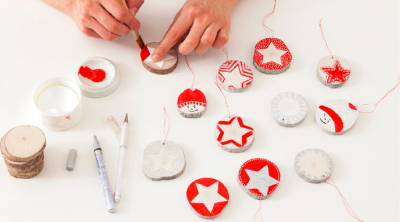 Pin
Pin  Pin
Pin Painted baubles have become an increasingly popular way to decorate homes during the Christmas season
Painted baubles have become an incredibly popular decorative item during the Christmas season. These small, spherical ornaments are typically made of glass or plastic and are painted with intricate designs, vibrant colors, and festive motifs.
One of the main reasons why painted baubles have gained such popularity is because they add a touch of personalization and uniqueness to Christmas decorations. While there are countless mass-produced baubles available in stores, painted baubles offer an opportunity to showcase individual artistic flair and creativity. People can choose to paint their own baubles or commission artists to create custom designs, resulting in truly one-of-a-kind pieces.
The process of painting baubles can be as simple or complex as desired. Some individuals prefer to paint their baubles with a single color or pattern, while others prefer to create elaborate scenes or detailed portraits. The paint used for this purpose is typically a combination of acrylic or glass enamel paints, which adhere well to the surface of the bauble and provide a glossy finish.
When it comes to designs, the options are limitless. Traditional Christmas icons such as snowflakes, reindeer, Santa Claus, and Christmas trees are popular choices. However, paintings can also incorporate more contemporary and unique themes, such as winter landscapes, abstract patterns, or even family portraits. The choice of colors is also important, with the traditional Christmas color palette of red, green, gold, and silver being particularly popular.
Designing and painting a bauble is not just a creative endeavor, but it can also be a fun and engaging activity for individuals or families during the holiday season. Many people host bauble painting parties where friends and family gather to create their own unique ornaments. This fosters a sense of togetherness and allows for shared memories and creative exploration.
Once the baubles are painted and dried, they can be hung on Christmas trees or placed in various other parts of the home. The glistening baubles catch the light and add a touch of sparkle and festive cheer to any room. They can also be used as gifts or keepsakes, treasured for years to come.
Painted baubles have become an increasingly popular way to decorate homes during the Christmas season. These unique ornaments allow individuals to showcase their creativity, create personalized decorations, and add a touch of charm to their holiday celebrations. Whether painting simple designs or intricate masterpieces, the process of creating and displaying painted baubles is a beloved Christmas tradition for many.
There are various materials and techniques used to create painted baubles, depending on the desired style and level of intricacy. Some commonly used materials include:
- 1. Glass: These are the most traditional and popular materials used for baubles. Glass baubles allow for intricate designs and vibrant colors.
- 2. Plastic: Plastic baubles are lightweight and less fragile than glass, making them a popular choice for households with pets or children. They are often used for mass-produced baubles.
- 3. Wood: Wooden baubles provide a vintage and rustic look. They can be painted directly or covered with fabric or paper before painting.
- 4. Ceramic: Ceramic baubles are sturdy and can be painted with glazes or acrylic paints. They are commonly used for hand-painted, personalized baubles.
The techniques used to paint baubles differ based on the materials, but common techniques include:
- 1. Hand-Painting: This traditional technique involves using small brushes and specialized paints such as acrylics or glass paints to create intricate designs on the bauble’s surface.
- 2. Decoupage: In this technique, paper or fabric cut-outs are adhered to the bauble’s surface using a decoupage glue or Mod Podge. The bauble is then painted over to blend the cut-outs with the base color.
- 3. Stenciling: Stencils with various patterns or motifs are used with paint to achieve consistent and repetitive designs on the baubles.
Popular designs and motifs for painted baubles vary based on current trends and personal preferences. Some commonly seen designs include:
- 1. Floral Patterns: Flowers are a classic choice, and various styles such as roses, poinsettias, or holly are often painted onto baubles.
- 2. Snowflakes: Snowflakes are a popular motif for winter and Christmas-themed baubles. They can be simple or intricate, with delicate details.
- 3. Animals: Cute animal designs, such as reindeer, polar bears, birds, or penguins, are often painted onto baubles, adding a whimsical touch to the tree decorations.
- 4. Traditional Patterns: Festive patterns like tartan, tartan plaid, or Nordic designs are commonly used for a traditional and cozy Christmas feel.
- 5. Personalized Baubles: Many people opt for personalized baubles that feature names, initials, or family photos, to commemorate special events or create unique gifts.
Ultimately, the design possibilities for painted baubles are endless, allowing individuals to showcase their creativity and style during the holiday season.
Some popular design ideas or themes for painted baubles during the holiday season include:
- 1. Traditional designs: Classic holiday motifs like snowflakes, wreaths, holly, and stars.
- 2. Nordic-inspired patterns: Scandinavian designs featuring reindeer, folk-inspired patterns, and geometric shapes.
- 3. Rustic and natural themes: Designs incorporating organic elements like pinecones, woodland animals, and winter landscapes.
- 4. Christmas characters: Painted baubles featuring beloved characters like Santa Claus, snowmen, elves, or even popular fictional characters with a holiday twist.
- 5. Whimsical and playful designs: Fun and imaginative designs like polka dots, stripes, candy canes, or colorful patterns.
- 6. Personalized baubles: Customized baubles with names, initials, or monograms, or even family photos for a personal touch.
- 7. Modern and minimalistic: Simple and sophisticated designs with muted colors, metallic accents, or abstract patterns.
- 8. Vintage-inspired: Designs evoking a nostalgic feel, such as antique motifs, old-fashioned Santas, or retro illustrations.
- 9. Cultural and religious motifs: Baubles featuring symbols and designs from different holiday traditions, such as Hanukkah menorahs, Kwanzaa’s kinara, or Diwali’s diyas.
- 10. Seasonal greetings: Baubles with festive messages or quotes, like “Merry Christmas,” “Joy to the World,” or “Happy Holidays.”
These are just a few ideas, and there are countless possibilities for painting baubles during the holiday season. The design choice ultimately depends on personal preference, the desired theme or style, and the overall decor of the holiday display.
Painted baubles can be a more sustainable and eco-friendly alternative to traditional plastic or glass ornaments, depending on the materials and paints used. Here are some considerations:
- 1. Bauble Materials: Instead of using plastic or glass baubles, opt for natural and biodegradable materials such as wood, paper, or fabric. These materials have a lower environmental impact and can decompose over time.
- 2. Paints: Choose eco-friendly and non-toxic paints to decorate your baubles. Acrylic or water-based paints are generally considered safer and have less impact on the environment compared to oil-based paints. Look for paints that are labeled as non-toxic, low in volatile organic compounds (VOCs), and free from heavy metals.
- 3. Natural Dyes: Another option is to use natural dyes instead of traditional paints. You can create dyes from various plant-based materials like spinach (green), beets (pink), turmeric (yellow), or blueberries (blue). Natural dyes are environmentally friendly and biodegradable.
- 4. Sealants: If you want to protect the paint on your baubles, choose water-based sealants. Avoid sealants that contain toxic chemicals such as formaldehyde or other harmful solvents.
- 5. Upcycling: Instead of buying new baubles, consider upcycling old ones. You can repaint existing baubles or use materials you already have at home to create unique designs. Upcycling helps reduce waste and gives a new life to old ornaments.
Remember to store and reuse your painted baubles for future years to reduce waste. By following these recommendations, you can create beautiful and eco-friendly decorations for your holiday season.
Painted baubles have a rich history and play a significant role in Christmas traditions
The history and significance of painted baubles in Christmas traditions can be traced back to Germany in the mid-19th century. Before the introduction of baubles, Christmas trees were traditionally decorated with fruits, nuts, and candles.
The use of painted baubles began when Hans Greiner, a German glassblower, was inspired by the beauty of apples hanging on an evergreen tree during a snowy Christmas season. He decided to create glass versions of these apples to be used as ornaments. The popularity of these ornaments grew rapidly, and soon glassblowers across Germany started making baubles in various shapes, sizes, and colors.
Baubles became an integral part of Christmas tree decorations due to their beauty and durability. The colorful glass balls added a touch of elegance and festivity to the trees. As their popularity spread, they became associated with the joy and merriment of the Christmas season.
Over time, baubles have evolved and expanded in design. From simple round balls, they now come in various shapes like stars, hearts, animals, and even cartoon characters. The materials used have also diversified, with plastic and other materials commonly used alongside glass.
Today, painted baubles remain a staple in Christmas traditions worldwide. They represent the beauty and magic of the holiday season, bringing joy, happiness, and a festive atmosphere to homes and public spaces. They allow individuals to express their creativity and add a personal touch to their Christmas decorations.
In addition to their decorative significance, baubles have also become collectible items. Vintage or unique baubles are highly sought after by collectors and can hold sentimental value for families, passed down from generation to generation.
Painted baubles have a rich history and play a significant role in Christmas traditions, bringing beauty, joy, and a festive spirit to the holiday season.
Frequently Asked Questions: Painted baubles for Christmas
Painted baubles for Christmas are small, decorative ornaments typically made of glass or plastic that are painted with festive designs or patterns. They are commonly used to adorn Christmas trees or as decorative accents around the home during the holiday season.
Painted baubles are usually made from a hollow glass or plastic sphere, which is first painted with a base color. Artists or designers then apply various paint techniques, such as hand painting, stenciling, or decoupage, to create intricate designs or patterns on the bauble’s surface. Sometimes, additional embellishments such as glitter, sequins, or ribbons are added for extra sparkle and texture.
Yes, many artisans or companies offer customization options for painted baubles. You can often request specific colors, designs, or even personalization with names, initials, or messages. Customizing painted baubles can be a great way to add a special touch to your holiday decorations or create unique gifts for loved ones.
Painted baubles should be handled with care to preserve their beauty and protect them from damage. Avoid dropping or mishandling them, as they can easily break. If the baubles are made of glass, they should be stored in a safe place where they won’t crash into each other or hard surfaces. Cleaning can be done gently with a soft, lint-free cloth to remove dust or fingerprints.
Painted baubles are generally designed for indoor use or in covered outdoor spaces. Exposure to extreme weather conditions like rain, snow, or direct sunlight can cause the paint to fade or deteriorate. If you wish to use them outdoors, make sure they are protected from the elements to maintain their appearance and longevity.
The lifespan of painted baubles can vary depending on the quality, materials used, and how they are handled or stored. With proper care, they can last for several years and be reused season after season. However, over time, the paint may fade or chip, and decorations like glitter or ribbon may come loose. It is always recommended to inspect and replace damaged or deteriorated baubles to ensure the safety and beauty of your decoration.
Painted baubles for Christmas are available in various stores, both physical and online, that offer seasonal decorations. Art and craft fairs, Christmas markets, or galleries specializing in handmade crafts are also great places to find unique and creatively painted baubles. Additionally, many artisans and artists sell their painted baubles through their own websites or online marketplaces, allowing you to support small businesses and find truly distinctive pieces.
Absolutely! If you have a creative streak or enjoy crafting, you can easily create your own painted baubles for Christmas. Craft stores usually offer plain baubles that you can decorate, and there are numerous online tutorials or DIY kits available to guide you through the process. This can be a fun and meaningful activity to do with family or friends, allowing you to showcase your artistic skills and add a personal touch to your holiday decor.












